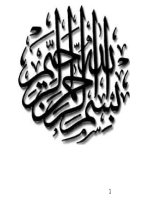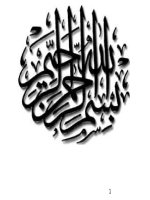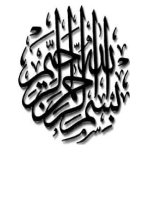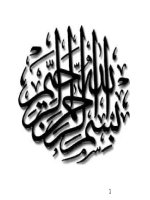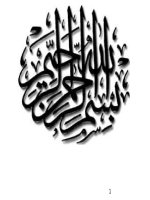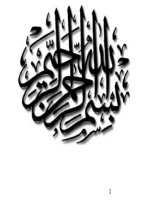Web technologies and e-services: Lecture 6 - Dr. Thanh Chung Dao
Bạn đang xem bản rút gọn của tài liệu. Xem và tải ngay bản đầy đủ của tài liệu tại đây (7.76 MB, 24 trang )
Web Development
Chapter 6. CSS
1
Before and after using CSS
2
2
1
u
u
login.html
…
<link rel="stylesheet" type="text/css" href=“style.css">
u
…
u
<tr class="formstyle"><td>
u
style.css
….
body
{
}
.formstyle
{
}
font-family: Verdana,Tahoma,Geneva,Arial,Helvetica,sans-serif;
font-size: 12px; …
background-color: #D7E5F5;
font-family: Verdana,Tahoma,Geneva,Arial,Helvetica,sans-serif;
font-size: 12px;
.forumline
{
}…
background-color: …
3
3
Content
1. Introduction to CSS
2. Specifying and applying style rules
3. Style class
4. Some useful properties
5. CSS box model
4
4
2
1. Introduction to CSS
u Cascading
Style Sheet
u Created by Hakon Wium Lie of MIT in
1994
u Has become the W3C standard for
controlling visual presentation of web
pages
5
5
1.1. Benefits of CSS
Simple syntax: easy to learn
u Powerful and flexible way to specify the
formatting of HTML elements
u
– Can define font, size, background color,
background image, margins, etc
u
Separates presentation (design elements)
from content (structural logic)
– HTML contains content and structure of a web
page.
– CSS defines a style of a web page – how the
content is displayed
6
3
1.1. Benefits of CSS (2)
u
Share style sheets across multiple
documents or entire Web site
– Easy to maintain consistent pages
– Can update a common style à Reflected in all
pages that use it
u
Cost Savings
– Reduced Bandwidth Costs
u One
style sheet called and cached
u CSS require less code
– Higher Search Engine Rankings
u Cleaner
u Greater
code is easier for search engines to index
density of indexable content
7
1.2. CSS Basics
u CSS
defines the way that HTML
elements should be presented:
– Positioning (e.g. left, right or centered)
– Font (size and family)
– Text decoration (e.g. underlined)
– Borders (solid, dashed, invisible)
– Image usage (e.g. for backgrounds and
bullets)
8
4
1.3. CSS Does Not…
u
Re-order HTML
– E.g. won’t sort a table
u
Perform calculations
– Won’t sum a shopping basket
u
Filter
– Won’t decide what to show
– Though JavaScript can set display or visibility
of elements in order to achieve this
u
These can all be done on the server
– Or using XSLT or JavaScript on the client
9
1.4. Types of CSS Styles
u
u
(Browser default)
External styles
– written in a separate document and then attached to
various Web documents
– External style sheets can affect any document they are
attached to
u
Internal styles (embedded styles)
– embedded in the head of the document.
– embedded styles affect only the tags on the page they
are embedded in
u
Inline Style
– written directly in the tag on the document
10
10
5
Content
1. Introduction to CSS
2. Specifying and applying style rules
3. Style class
4. Some useful properties
5. CSS box model
11
11
2.1. Specifying Style Rules
u
General form of rule
selector { property: value }
Or
selector { property1: value1;
property2: value2;
...
propertyN: valueN }
u
Example
H1 { text-align: center;
color: blue }
12
12
6
2.1. Specifying Style Rules (2)
The selector is the link between the HTML
document and the style. It specifies what
elements are affected by the declaration.
u The declaration is that part of the rule that
sets forth what the effect will be
u
13
13
2.1. Specifying Style Rules (3)
u
Grouping selectors and rules
H1 { font-weight: bold }
H2 { font-weight: bold }
H3 { font-weight: bold }
àH1, H2, H3 { font-weight: bold }
àWhat is different?
b i{background-color:yellow;}
b,i{color:blue;}
u
A selector may have more than one
declaration
H1 { color: green }
H1 { text-align: center }
14
14
7
2.2. Applying styles to the
document
u
Inline style
– Apply a style sheet to an individual element
using the style attribute
u
Embedded style
– Apply the basic, document-wide style sheet for
the document by using the style element
u External
style
– Link an external style sheet to the document
using the link element or
– Import a style sheet using the CSS @import
notation.
15
15
2.2.1. Inline style
u Using
Style attribute
u For individual elements
<H1 STYLE=“color: blue; font-size: 20pt;”>
A large purple Heading
</H1>
16
16
8
2.2.2. Embedded style
u
u
Using Style element
Putting the style sheet inside a style element at
the top of your document
<HTML>
<HEAD><TITLE>Bach's home page</TITLE>
<STYLE> H1, H2 { color: green } </STYLE>
</HEAD>
<BODY>
<H1>Bach's home page</H1>
<P>Johann Sebastian Bach was a prolific composer. Among his
works are: <UL> <LI>the Goldberg Variations
<LI>the Brandenburg Concertos
<LI>the Christmas Oratorio </UL>
<H2>Historical perspective</H2>
<P>Bach composed in what has been referred to as the Baroque
period.
</BODY>
</HTML>
17
17
2.2.2. Embedded style (2)
<STYLE type=“text/css”>
H1, H2 { color: green }
-->
</STYLE>
18
18
9
Tree structures and inheritance
Just as children inherit from their parents,
HTML elements inherit stylistic properties.
u CSS property values set on one element
will be transferred down the tree to its
descendants
u
<STYLE TYPE="text/css">
BODY { color: green }
</STYLE>
19
19
Overriding inheritance
u Sometimes
children don't look like
their parents.
u E.g.
<STYLE TYPE="text/css">
BODY { color: green }
H1 { color: navy }
</STYLE>
20
20
10
2.2.3. External style
u
u
u
Using Link element
This is true “separation” of style and content.
Keeping all your styles in an external document is simpler
<HEAD>
<LINK REL=“stylesheet” TYPE=“text/css” HREF=“styles/mystyles.css”>
</HEAD>
/* mystyles.css - a simple style sheet */
body {
margin-left: 10%;
margin-right: 10%;
color: black;
background: white;
}
21
21
Content
1. Introduction to CSS
2. Specifying and applying style rules
3. Style class
4. Some useful properties
5. CSS box model
22
22
11
3.1. Element Style Classes
u
Proceed the HTML element by a period and a class
name
// Define an "abstract" paragraph type
P.abstract { margin-left: 0.5in;
margin-right: 0.5in;
font-style: italic }
u
To use, supply the name of the style class in the
CLASS attribute of the HTML element
<H1>New Advances in Physics</H1>
<P CLASS="abstract">
This paper gives the solution to three previously
unsolved problems: turning lead into gold,
antigravity, and a practical perpetual motion machine.
23
23
3.2. Global Style Classes
u
omit the element name
// Style available to all elements
.blue { color: blue; font-weight: bold }
u
To use, simple specify the style class in
the CLASS attribute of the HTML element
<H2 CLASS="blue">A Blue Heading</H2>
<!-- Apply to a section of text -->
This text is in the default color, but
<SPAN CLASS="blue">this text is blue.</SPAN>
24
24
12
3.3. Styles through User-Defined IDs
u
An ID is like a class but can be applied
only once in a document
<HEAD>
<TITLE>...</TITLE>
<STYLE TYPE="text/css">
-->
</STYLE>
</HEAD>
<BODY>
...
<P ID="foo">
...
</BODY>
25
25
Content
1. Introduction to CSS
2. Specifying and applying style rules
3. Style class
4. Some useful properties
5. CSS box model
26
26
13
4.1. Useful Font Properties
u
font-weight
– Relative weight (boldness) of font
– normal | lighter | bold | bolder | 100 | 200 | ... | 900
H1 { font-weight : 200 }
H2 { font-weight : bolder }
u
font-style
– Font face type within a family
– normal | italic | oblique
P { font-style : normal }
TH { font-sytle : italic }
27
27
4.1. Useful Font Properties (2)
u
font-size
– Either relative or absolute size of font
– pt, pc, in, cm, mm | em, ex, px, % | xx-large | x-large |
large | medium | small | x-small | xx-small | smaller |
larger
STRONG { font-size: 150% }
P { font-size: 14pt }
P { font-size: xx-large }
u
font-family
– Typeface family for the font
H1 { font-family: Arial }
28
28
14
4.2. Useful Text Properties
u
text-decoration
– Describes text additions or “decorations” that are added to the
text of an element
– none | underline | overline | line-through | blink
– E.g. P { text-decoration: underline }
u
vertical-align
– Determines how elements are positioned vertically
– top | bottom | baseline | middle | sub | super | text-top |
text-bottom | %
u
text-align
– Determines how paragraphs are positioned horizontally
– left | right | center | justify
29
29
4.2. Useful Text Properties (2)
u
text-indent
– Specifies the indentation of the first line of the
paragraph
– +/– pt, pc, in, cm, mm | +/– em, ex, px, %
– E.g. P { text-indent: -25px } /* Hanging indent */
u
line-height
– Specifies the distance between two
consecutive baselines in a paragraph
– normal | number | pt, pc, in, cm, mm | em, ex, px, %
.double { line-height: 200% }
.triple { line-height: 3 } /* 3x the font size */
DIV { line-height: 1.5em }
30
30
15
4.3. Useful Foreground and
Background Properties
u
color
– Color of the text or foreground color
– color-name | #RRGGBB | #RGB | rgb(rrr, ggg, bbb) |
rgb(rrr%, ggg%, bbb%)
P { color : blue }
H1 { color : #00AABB }
H3 { color : rgb(255, 0, 0 ) } /* red */
u
background-image
– Specifies an image to use as the background of region
– none | url(filename)
H2 { background-image: url(Bluedrop.gif);}
31
31
4.3. Useful Foreground and
Background Properties (2)
u
background-repeat
– Specifies how to tile the image in the region
– repeat | repeat-x | repeat-y | norepeat
BODY {
background-image: url(Bluedot.gif);
background-repeat: repeat-x;
}
u
background
– Lets you combine properties in a single entry
P { background: url(wallpaper.jpg) repeat-x }
32
32
16
Content
1. Introduction to CSS
2. Specifying and applying style rules
3. Style class
4. Some useful properties
5. CSS box model
33
33
5. CSS Box Model
u
u
Each HTML element have the rectangular “box”
Each box has a content area and optional
surrounding padding, border and margin area
Left
Top
Margin
Border
Padding
Content (Text/Image)
Right
Bottom
34
17
CSS Box Model - example
div#boxtest {
background-color: red; color: white;
padding: 1em;
border: 1em solid green;
margin: 1em;
}
Left
Top
Margin
Border
Padding
Content (Text/Image)
Right
Bottom
35
CSS Box Model - color
Padding - same as the element’s
background-color
u Border - may have its own color (bordercolor property)
u Margin - always transparent
(same as its ancestor's background-color)
u
Margin
Border
Padding
Content (Text/Image)
36
18
CSS Box Model - edge sizes
u
u
u
u
Inner edge (Black line): Content itself or CSS width
and height property may define the size
Padding edge (Pink): IE + padding width
Border edge (Brown): PE + border width
Outer (margin) edge (Dotted): BE + margin width
37
CSS Box Model – width (1)
u
margin, padding, border-width
– Define the width for all directions at once
u
margin-top, padding-top, border-top-width
– Define the width for each specific direction
– top, right, left, bottom
Top
Margin
Border
Padding
Content
Left
(Text/Image)
Right
Bottom
38
19
CSS Box Model – width (2)
Effective values for box width
u <length> - e.g. 10pt, 3px, 1.2em
u
– Effective for border, padding, margin
u
– Effective only for padding, margin
– Calculated with respect to the width of the
generated box’s containing block
u
Thin, medium, thick
– Effective only for border
39
Border properties
u
border-width or border-top-width (top, right, left,
bottom)
u
border-color or border-top-color (top, right, left,
bottom)
– Specify the line width
– Specify the line color by the color name or RGB values
u
border-style or border-top-style (top, right, left,
bottom)
– Specify the line style of box’s border
– Values: solid, dotted, dashed, double, groove, ridge, inset,
outset, hidden
– Special value “none” means width 0
u
border or border-top (top, right, left, bottom)
– shorthand property for setting the width, style, and color
– e.g. “border: 1em solid black;”
40
20
TIPS: Before your experiment of
box model
u Web
browsers define their own
default margin and padding width for
some elements
u To override them, insert this CSS
code at first
*{
}
margin: 0;
padding: 0;
41
Page layout with
CSS box and div element
u
Typical page layout with four regions
– main, header, footer, sidebar
u
Enclosed by div elements with id attributes
<div id="header">
Header content
</div>
<div id="sidebar">
Sidebar content
</div>
<div id="main">
Main content
</div>
<div id="footer">
Footer content
</div>
header
main
sidebar
footer
42
21
Layout (1): header
Reset default margin and padding to 0
u Specify header’s property
u
*{
margin: 0;
padding: 0;
}
body {
background-color: white;
color: black;
}
div#header {
background-color: red;
color: white;
}
header
main
sidebar
footer
43
Layout (2): main
u Specify
main region’s properties
u Set its height and shift to left side
div#main {
float: left;
height: 400px;
}
header
sidebar
footer
main
44
22
Layout (3): sidebar
Specify sidebar’s properties
u Set its height and shift to right side
u Restrict sidebar’s width to 25% of the
parent
u
div#sidebar {
float: right;
height: 400px;
width: 25%;
background-color:
yellow;
color: black;
}
header
main
foo
ter
footer
sidebar
45
Layout (4): footer
Specify footer’s properties
u Use “clear: both;” property
u
– not be adjacent to an earlier floating box
div#footer {
clear: both;
background-color:
blue;
color: white;
}
header
main
sidebar
footer
46
23
Question?
47
47
24
